Discharge Energy as a Key Contributing Factor Determining Microgeometry of Aluminum Samples Created by Electrical Discharge Machining
Abstract
:1. Introduction
2. Materials and Methods
2.1. Sample Preparation
2.2. Measurements and Filtration
- dataset leveling—in this operation non-measured points and their neighboring areas were excluded from the calculation of the least square polynomial surface of 1st degree. There was no form-removal step since the samples were manufactured as a flat surface and form deviation would not clearly manifest itself in the relatively small measurement area;
- thresholding—this operation generally aids in the next step of software-driven outliers removal, which does not always remove larger spikes, and plateau-like artifacts, which are characteristic of FVM measurements [44]. Generally, for other surface morphologies, this step would be omitted and only outliers removal procedure would be performed [45];
- outliers removal—the built-in software operation was used to remove the outliers, i.e., spikes, vertical slopes, etc.;
- filling in non-measured points—in this operation non-measured points were replaced with a smooth shape calculated from the neighbors. In order to avoid the reappearance of previously present artifacts, non-measured zones were dilated by 1.5 µm. None of the measured surfaces contained significantly large (>15 µm in diameter) non-measured areas.
2.3. Surface Characterization Methods
2.3.1. Standard Analysis with ISO Parameters (MM)
2.3.2. Length-Scale and Area-Scale Analyses
2.3.3. Multiscale Curvature Analysis
2.4. Discrimination Analysis
3. Results
3.1. Measurements of Surface Topographies
3.2. Standard Analysis with ISO Parameters
3.3. Length- and Area-Scale Analyses
3.4. Curvature
4. Discussion
5. Conclusions
- Strong correlations (R2 > 0.9) were found between the electrical discharge energy values and the topographic parameters of the surface:
- ○
- Rel, Lsfc for scales >90 µm, RelA, Asfc for scales ranging between 2400 and 138,000 µm
- ○
- Curvature statistical measures (apart from κ2a) starting from scales between 36 a 41 µm.
- The highest coefficients of determination were noted generally for the coarse scales of observation in which geometrical properties of large size morphological features are best characterized. The strongest coefficients of determination R2 > 0.9 were noted for linear (0.993 for Ka at scale = 41 µm, 0.951 for Rel at scale = 111.38 µm) and exponential regressions (0.957 for Rel at scale 51.49 µm);
- Length- and area-scale analyses performed the best at discriminating the surfaces. A similar observation was made for curvature, apart from standard deviations of both signed and signed maximum curvature was considered, which failed at finest scales (<11 µm);
- The convergence of the results obtained by the considered multiscale methods is high for intermediate scales although the definition of scale differs depending on the method;
- Apart from average mean curvature (Ha), characterizations of fine-scale features do not correlate strongly with the energy of electrical discharges using the proposed linear, logarithmic, and exponential models (as R2 < 0.9), although surfaces can be confidently discriminated at those corresponding scales. A more complex statistical model should be considered in those cases;
- Conventional surface characterization parameters generally do not correlate well with the discharge weakly. Some exceptions were found for Sv, Spc, Shv, and Spar for which R2 was found to be greater than 0.9;
- The effect of the discharge energy is shown in the magnitude of the surface principal curvatures and their combinations. This relationship is evident mainly for the three mean measures: κ1a, Ha, and Ka and occurs starting from the intermediate scales (between 36 and 41 µm).
Supplementary Materials
Author Contributions
Funding
Conflicts of Interest
Appendix A
| Abbrevation | Full Name |
|---|---|
| Sq | Root-mean-square height |
| Ssk | Skewness |
| Sku | Kurtosis |
| Sp | Maximum peak height |
| Sv | Maximum pit height |
| Sz | Maximum height |
| Sa | Arithmetic mean height |
| Smr | Areal material ratio |
| Smc | Inverse areal material ratio |
| Sxp | Extreme peak height |
| Sal | Autocorrelation length |
| Str | Texture-aspect ratio |
| Std | Texture direction |
| Sdq | Root-mean-square gradient |
| Sdr | Developed interfacial area ratio |
| Vm | Material volume |
| Vv | Void volume |
| Vmp | Peak material volume |
| Vmc | Core material volume |
| Vvc | Core void volume |
| Vvv | Pit void volume |
| Spd | Density of peaks |
| Spc | Arithmetic mean peak curvature |
| S10z | Ten point height |
| S5p | Five point peak height |
| S5v | Five point pit height |
| Sda | Mean dale area |
| Sha | Mean hill area |
| Sdv | Mean dale volume |
| Shv | Mean hill volume |
| Sbi | Surface bearing index |
| Sci | Core fluid retention index |
| Svi | Valley fluid retention index |
| Smean | Mean height in absolute |
| Sdar | Developed area |
| Spar | Projected area |
| Rel | Relative length |
| RelA | Relative area |
| Lsfc | Length-scale fractal complexity |
| Asfc | Area-scale fractal complexity |
| κ1a | Average maximum curvature |
| κ1q | Standard deviation of maximum curvature |
| κ2a | Average minimum curvature |
| κ2q | Standard deviation of minimum curvature |
| Ha | Average mean curvature |
| Hq | Standard deviation of mean curvature |
| Ka | Average Gaussian curvature |
| Kq | Standard deviation of Gaussian curvature |
| κ1aabs | Average absolute maximum curvature |
| κ1qabs | Standard deviation of absolute maximum curvature |
| κ2aabs | Average absolute minimum curvature |
| κ2qabs | Standard deviation of absolute minimum curvature |
| Haabs | Average absolute mean curvature |
| Hqabs | Standard deviation of absolute mean curvature |
| Kaabs | Average absolute Gaussian curvature |
| Kqabs | Standard deviation of absolute Gaussian curvature |
| Parameter | R2 Linear Regression | R2 Logarithmic Regression | R2 Exponential Regression |
|---|---|---|---|
| Sq | 0.833 | 0.776 | 0.577 |
| Ssk | 0.238 | 0.593 | N/A |
| Sku | 0.000 | 0.010 | 0.001 |
| Sp | 0.732 | 0.826 | 0.500 |
| Sv | 0.900 | 0.655 | 0.718 |
| Sz | 0.827 | 0.773 | 0.599 |
| Sa | 0.826 | 0.779 | 0.568 |
| Smr (c = 1 µm under the highest peak) | 0.392 | 0.355 | 0.755 |
| Smc (p = 10%) | 0.838 | 0.784 | 0.573 |
| Sxp (p = 50%, q = 97.5%) | 0.857 | 0.698 | 0.620 |
| Sal (s = 0.2) | 0.700 | 0.733 | 0.629 |
| Str (s = 0.2) | 0.060 | 0.336 | 0.046 |
| Std (Reference angle = 0°) | 0.006 | 0.046 | 0.006 |
| Sdq | 0.794 | 0.842 | 0.558 |
| Sdr | 0.732 | 0.857 | 0.461 |
| Vm (p = 10%) | 0.801 | 0.808 | 0.532 |
| Vv (p = 10%) | 0.836 | 0.785 | 0.571 |
| Vmp (p = 10%) | 0.801 | 0.808 | 0.532 |
| Vmc (p = 10%, q = 80%) | 0.802 | 0.784 | 0.548 |
| Vvc (p = 10%, q = 80%) | 0.830 | 0.793 | 0.563 |
| Vvv (p = 80%) | 0.889 | 0.623 | 0.676 |
| Spd (pruning = 2.5%) | 0.320 | 0.393 | 0.572 |
| Spc (pruning = 2.5%) | 0.925 | 0.592 | 0.869 |
| S10z (pruning = 2.5%) | 0.809 | 0.776 | 0.585 |
| S5p (pruning = 2.5%) | 0.732 | 0.820 | 0.494 |
| S5v (pruning = 2.5%) | 0.883 | 0.648 | 0.727 |
| Sda (pruning = 2.5%) | 0.874 | 0.731 | 0.638 |
| Sha (pruning = 2.5%) | 0.779 | 0.698 | 0.534 |
| Sdv (pruning = 2.5%) | 0.899 | 0.775 | 0.508 |
| Shv (pruning = 2.5%) | 0.947 | 0.623 | 0.594 |
| Sbi | 0.196 | 0.004 | 0.165 |
| Sci | 0.394 | 0.723 | 0.374 |
| Svi | 0.118 | 0.497 | 0.113 |
| Smean | 0.780 | 0.429 | N/A |
| Sdar | 0.738 | 0.855 | 0.693 |
| Spar | 0.909 | 0.262 | 0.826 |
References
- Marashi, H.; Sarhan, A.; Maher, I.; Sayuti, M. 1.7 Techniques to Improve EDM Capabilities: A Review. Compr. Mater. Finish. 2017, 1–3, 171–202. [Google Scholar] [CrossRef]
- Lauwers, B.; Vleugels, J.; Malek, O.; Brans, K.; Liu, K. Electrical discharge machining of composites. Mach. Technol. Compos. Mater. 2012, 202–241. [Google Scholar] [CrossRef]
- Slătineanu, L.; Dodun, O.; Coteaţă, M.; Nagîţ, G.; Băncescu, I.; Hriţuc, A. Wire Electrical Discharge Machining—A Review. Machines 2020, 8, 69. [Google Scholar] [CrossRef]
- Panda, R.C.; Sharada, A.; Samanta, L.D. A review on electrical discharge machining and its characterization. Mater. Today Proc. 2021. [Google Scholar] [CrossRef]
- Ho, K.; Newman, S. State of the art electrical discharge machining (EDM). Int. J. Mach. Tools Manuf. 2003, 43, 1287–1300. [Google Scholar] [CrossRef]
- Calvo, R.; Daniel, M. Wire electrical discharge machining (EDM) setup parameters influence in functional surface roughness. Procedia Manuf. 2019, 41, 602–609. [Google Scholar] [CrossRef]
- Braatz, R.; Alkire, R.; Seebauer, E.; Rusli, E.; Gunawan, R.; Drews, T.; Li, X.; He, Y. Perspectives on the design and control of multiscale systems. J. Process. Control. 2006, 16, 193–204. [Google Scholar] [CrossRef]
- Meshram, D.B.; Puri, Y.M. Effective parametric analysis of machining curvature channel using semicircular curved copper electrode and OHNS steel workpiece through a novel curved EDM process. Eng. Res. Express 2019, 1, 015014. [Google Scholar] [CrossRef]
- Dhadda, G.; Hamed, M.; Koshy, P. Electrical discharge surface texturing for enhanced pool boiling heat transfer. J. Mater. Process. Technol. 2021, 293, 117083. [Google Scholar] [CrossRef]
- Gostimirovic, M.; Kovac, P.; Sekulic, M.; Skoric, B. Influence of discharge energy on machining characteristics in EDM. J. Mech. Sci. Technol. 2012, 26, 173–179. [Google Scholar] [CrossRef]
- Liu, Q.; Zhang, Q.; Zhang, M.; Yang, F. Study on the Time-Varying Characteristics of Discharge Plasma in Micro-Electrical Discharge Machining. Coatings 2019, 9, 718. [Google Scholar] [CrossRef] [Green Version]
- Bartkowiak, T.; Mendak, M.; Mrozek, K.; Wieczorowski, M. Analysis of Surface Microgeometry Created by Electric Discharge Machining. Materials 2020, 13, 3830. [Google Scholar] [CrossRef] [PubMed]
- Klocke, F.; Lung, D.; Antonoglou, G.; Thomaidis, D. The effects of powder suspended dielectrics on the thermal influenced zone by electrodischarge machining with small discharge energies. J. Mater. Process. Technol. 2004, 149, 191–197. [Google Scholar] [CrossRef]
- Wang, H.J.; Zuo, D.W.; Wu, X.; Wang, M. Relationship between the Fine Discharge Parameters and Craters EDMed of the NAK80 Steel. Key Eng. Mater. 2010, 426–427, 85–88. [Google Scholar] [CrossRef]
- Bartkowiak, T.; Brown, C.A. A Characterization of Process–Surface Texture Interactions in Micro-Electrical Discharge Machining Using Multiscale Curvature Tensor Analysis. J. Manuf. Sci. Eng. 2018, 140, 021013. [Google Scholar] [CrossRef]
- Lertphokanont, V.; Sato, T.; Ota, M.; Yamaguchi, K.; Egashira, K. Micro-Structuring on Cylindrical Inner Surface Using Whirling Electrical Discharge Texturing. Adv. Mater. Res. 2012, 565, 430–435. [Google Scholar] [CrossRef] [Green Version]
- Shao, B.; Rajurkar, K.P. Modelling of the Crater Formation in Micro-EDM. Procedia CIRP 2015, 33, 376–381. [Google Scholar] [CrossRef] [Green Version]
- Han, F.; Jiang, J.; Yu, D. Influence of discharge current on machined surfaces by thermo-analysis in finish cut of WEDM. Int. J. Mach. Tools Manuf. 2007, 47, 1187–1196. [Google Scholar] [CrossRef]
- Kurnia, W.; Tan, P.C.; Yeo, S.H.; Tan, Q.P. Surface roughness model for micro electrical discharge machining. Proc. Inst. Mech. Eng. Part B: J. Eng. Manuf. 2009, 223, 279–287. [Google Scholar] [CrossRef]
- Jithin, S. Modelling and Analysis of Surface Topographies Generated Using Electrical Discharge Texturing. Ph.D. Thesis, Indian Institute of Technology Bombay, Mumbai, India, 2020. [Google Scholar]
- Dmowska, A.; Nowicki, B.; Podolak-Lejtas, A. Surface Layer Properties after Successive EDM or EDA and Then Superficial Roto-Peen Machining. Adv. Tribol. 2012, 2012, 1–12. [Google Scholar] [CrossRef] [Green Version]
- Kumar, S.S.; Varol, T.; Canakci, A.; Kumaran, S.T.; Uthayakumar, M. A review on the performance of the materials by surface modification through EDM. Int. J. Light. Mater. Manuf. 2021, 4, 127–144. [Google Scholar] [CrossRef]
- Prathipati, R.; Dora, S.P.; Chanamala, R. Wear behavior of wire electric discharge machined surface of 316L stainless steel. SN Appl. Sci. 2020, 2, 412. [Google Scholar] [CrossRef] [Green Version]
- Peta, K.; Bartkowiak, T.; Galek, P.; Mendak, M. Contact angle analysis of surface topographies created by electric discharge machining. Tribol. Int. 2021, 163, 107139. [Google Scholar] [CrossRef]
- Khan, A.A.; Al Hazza, M.H.; Daud, M.R.H.C.; Kamal, N.S.B.M. Optimization of Surface Quality of Mild Steel Machined by Wire EDM Using Simulated Annealing Algorithm. In Proceedings of the 2015 4th International Conference on Advanced Computer Science Applications and Technologies (ACSAT), Kuala Lumpur, Malaysia, 8–10 December 2015; 2015; pp. 3–8. [Google Scholar] [CrossRef]
- Antar, M.; Hayward, P.; Dunleavey, J.; Butler-Smith, P. Surface Integrity Evaluation of Modified EDM Surface Structure. Procedia CIRP 2018, 68, 308–312. [Google Scholar] [CrossRef]
- Shen, D.; Ming, W.; Ren, X.; Xie, Z.; Liu, X. Progress in Non-Traditional Processing for Fabricating Superhydrophobic Surfaces. Micromachines 2021, 12, 1003. [Google Scholar] [CrossRef]
- Pagani, L.; Qi, Q.; Jiang, X.; Scott, P. Towards a new definition of areal surface texture parameters on freeform surface. Measurement 2017, 109, 281–291. [Google Scholar] [CrossRef]
- Brown, C.A.; Hansen, H.N.; Jiang, X.J.; Blateyron, F.; Berglund, J.; Senin, N.; Bartkowiak, T.; Dixon, B.; Le Goïc, G.; Quinsat, Y.; et al. Multiscale analyses and characterizations of surface topographies. CIRP Ann. 2018, 67, 839–862. [Google Scholar] [CrossRef]
- Bartkowiak, T.; Brown, C.A. Multiscale 3D Curvature Analysis of Processed Surface Textures of Aluminum Alloy 6061 T6. Materials 2019, 12, 257. [Google Scholar] [CrossRef] [PubMed] [Green Version]
- De Boer, G.N.; Gao, L.; Hewson, R.W.; Thompson, H.M.; Raske, N.; Toropov, V.V. A multiscale method for optimising surface topography in elastohydrodynamic lubrication (EHL) using metamodels. Struct. Multidiscip. Optim. 2016, 54, 483–497. [Google Scholar] [CrossRef] [Green Version]
- Barré, F.; Lopez, J. Watershed lines and catchment basins: A new 3D-motif method. Int. J. Mach. Tools Manuf. 2000, 40, 1171–1184. [Google Scholar] [CrossRef]
- Guibert, R.; Hanafi, S.; Deltombe, R.; Bigerelle, M.; A Brown, C. Comparison of three multiscale methods for topographic analyses. Surf. Topogr. Metrol. Prop. 2020, 8, 024002. [Google Scholar] [CrossRef]
- Le Goïc, G.; Bigerelle, M.; Samper, S.; Favrelière, H.; Pillet, M. Multiscale roughness analysis of engineering surfaces: A comparison of methods for the investigation of functional correlations. Mech. Syst. Signal Process. 2016, 66–67, 437–457. [Google Scholar] [CrossRef]
- Bigerelle, M.; Guillemot, G.; Khawaja, Z.; El Mansori, M.; Antoni, J. Relevance of Wavelet Shape Selection in a complex signal. Mech. Syst. Signal Process. 2013, 41, 14–33. [Google Scholar] [CrossRef]
- Bigerelle, M.; Iost, A. A new method to calculate the fractal dimension of surfaces: Application to human cell proliferation. Comput. Math. Appl. 2001, 42, 241–253. [Google Scholar] [CrossRef] [Green Version]
- Brown, C.; Charles, P.; Johnsen, W.; Chesters, S. Fractal analysis of topographic data by the patchwork method. Wear 1993, 161, 61–67. [Google Scholar] [CrossRef]
- Wolf, G.W. Scale independent surface characterisation: Geography meets precision surface metrology. Precis. Eng. 2017, 49, 456–480. [Google Scholar] [CrossRef]
- Klink, A.; Holsten, M.; Hensgen, L. Crater morphology evaluation of contemporary advanced EDM generator technology. CIRP Ann. 2017, 66, 197–200. [Google Scholar] [CrossRef]
- Hyde, J.M.; Cadet, L.; Montgomery, J.; Brown, C.A. Multi-scale areal topographic analysis of surfaces created by micro-EDM and functional correlations with discharge energy. Surf. Topogr. Metrol. Prop. 2014, 2, 2. [Google Scholar] [CrossRef]
- Jithin, S.; Joshi, S.S. Surface topography generation and simulation in electrical discharge texturing: A review. J. Mater. Process. Technol. 2021, 298, 117297. [Google Scholar] [CrossRef]
- Helmli, F. Focus Variation Instruments. In Optical Measurement of Surface Topography; Springer Science and Business Media LLC: Berlin, Germany, 2011; pp. 131–166. [Google Scholar]
- Lou, S.; Jiang, X.; Sun, W.; Zeng, W.; Pagani, L.; Scott, P. Characterisation methods for powder bed fusion processed surface topography. Precis. Eng. 2019, 57, 1–15. [Google Scholar] [CrossRef]
- Senin, N.; Thompson, A.; Leach, R. Characterisation of the topography of metal additive surface features with different measurement technologies. Meas. Sci. Technol. 2017, 28, 095003. [Google Scholar] [CrossRef]
- Podulka, P.; Pawlus, P.; Dobrzański, P.; Lenart, A. Spikes removal in surface measurement. J. Physics: Conf. Ser. 2014, 483, 012025. [Google Scholar] [CrossRef] [Green Version]
- Pawlus, P.; Reizer, R.; Wieczorowski, M. Problem of Non-Measured Points in Surface Texture Measurements. Metrol. Meas. Syst. 2017, 24, 525–536. [Google Scholar] [CrossRef]
- Pawlus, P.; Reizer, R.; Wieczorowski, M. Comparison of results of surface texture measurement obtained with stylus methods and optical methods. Metrol. Measurement Syst. 2018, 25, 589–602. [Google Scholar]
- De Groot, P.J. The Meaning and Measure of Vertical Resolution in Optical Surface Topography Measurement. Appl. Sci. 2017, 7, 54. [Google Scholar] [CrossRef]
- Zuo, X.; Peng, M.; Zhou, Y. Influence of noise on the fractal dimension of measured surface topography. Measurement 2020, 152, 107311. [Google Scholar] [CrossRef]
- Advanced Techniques for Assessment Surface Topography. Adv. Tech. Assess. Surf. Topogr. 2003, 1–355. [CrossRef]
- Townsend, A.; Senin, N.; Blunt, L.; Leach, R.; Taylor, J. Surface texture metrology for metal additive manufacturing: A review. Precis. Eng. 2016, 46, 34–47. [Google Scholar] [CrossRef] [Green Version]
- ASME B46. 1-2009 - Surface Texture (Surface Roughness, Waviness and Lay); ASME Int.: New York, NY, USA, 2010. [Google Scholar]
- Dansk Standard DS/EN ISO 25178-Geometrical Product Specification (GPS)—Surface Texture: Areal - Part 2: Terms, Definitions and Surface Texture Parameters. ISO 25178-Geometrical Product Specification (GPS)---Surface Texture: Areal—Part 2: Terms, Definitions and Surface Texture Parameters; ISO Standard: Geneva, Switzerland, 2012.
- Leach, R. Characterisation of Areal Surface Texture; Springer Sience & Business Media: Berlin/Heidelberg, Germany, 2013. [Google Scholar]
- Pagani, L.; Townsend, A.; Zeng, W.; Lou, S.; Blunt, L.; Jiang, X.Q.; Scott, P. Towards a new definition of areal surface texture parameters on freeform surface: Re-entrant features and functional parameters. Meas. 2019, 141, 442–459. [Google Scholar] [CrossRef]
- Jithin, S.; Bhandarkar, U.V.; Joshi, S.S. Three-dimensional topography analysis of electrical discharge textured SS304 surfaces. J. Manuf. Process. 2020, 60, 384–399. [Google Scholar] [CrossRef]
- Aich, U.; Banerjee, S. Characterizing topography of EDM generated surface by time series and autocorrelation function. Tribol. Int. 2017, 111, 73–90. [Google Scholar] [CrossRef]
- Podulka, P. Suppression of the High-Frequency Errors in Surface Topography Measurements Based on Comparison of Various Spline Filtering Methods. Mater. 2021, 14, 5096. [Google Scholar] [CrossRef]
- Pawlus, P. Digitisation of surface topography measurement results. Measurement 2007, 40, 672–686. [Google Scholar] [CrossRef]
- Barari, A.; Kishawy, H.A.; Kaji, F.; Elbestawi, M.A. On the surface quality of additive manufactured parts. Int. J. Adv. Manuf. Technol. 2017, 89, 1969–1974. [Google Scholar] [CrossRef]
- Gogolewski, D.; Bartkowiak, T.; Kozior, T.; Zmarzły, P. Multiscale Analysis of Surface Texture Quality of Models Manufactured by Laser Powder-Bed Fusion Technology and Machining from 316L Steel. Materials 2021, 14, 2794. [Google Scholar] [CrossRef] [PubMed]
- Jamiolahmadi, S.; Barari, A. Surface Topography of Additive Manufacturing Parts Using a Finite Difference Approach. J. Manuf. Sci. Eng. 2014, 136, 061009. [Google Scholar] [CrossRef]

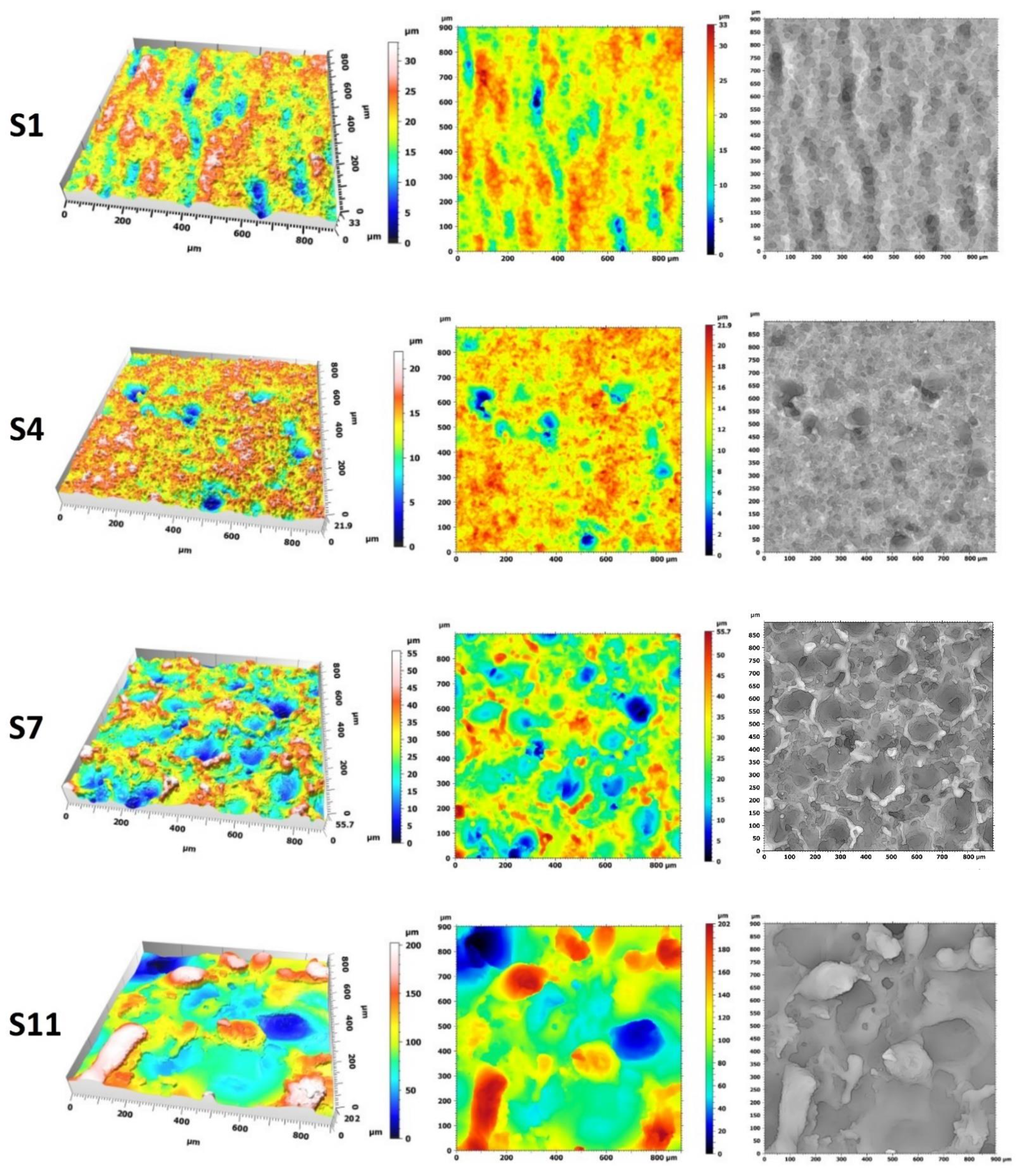
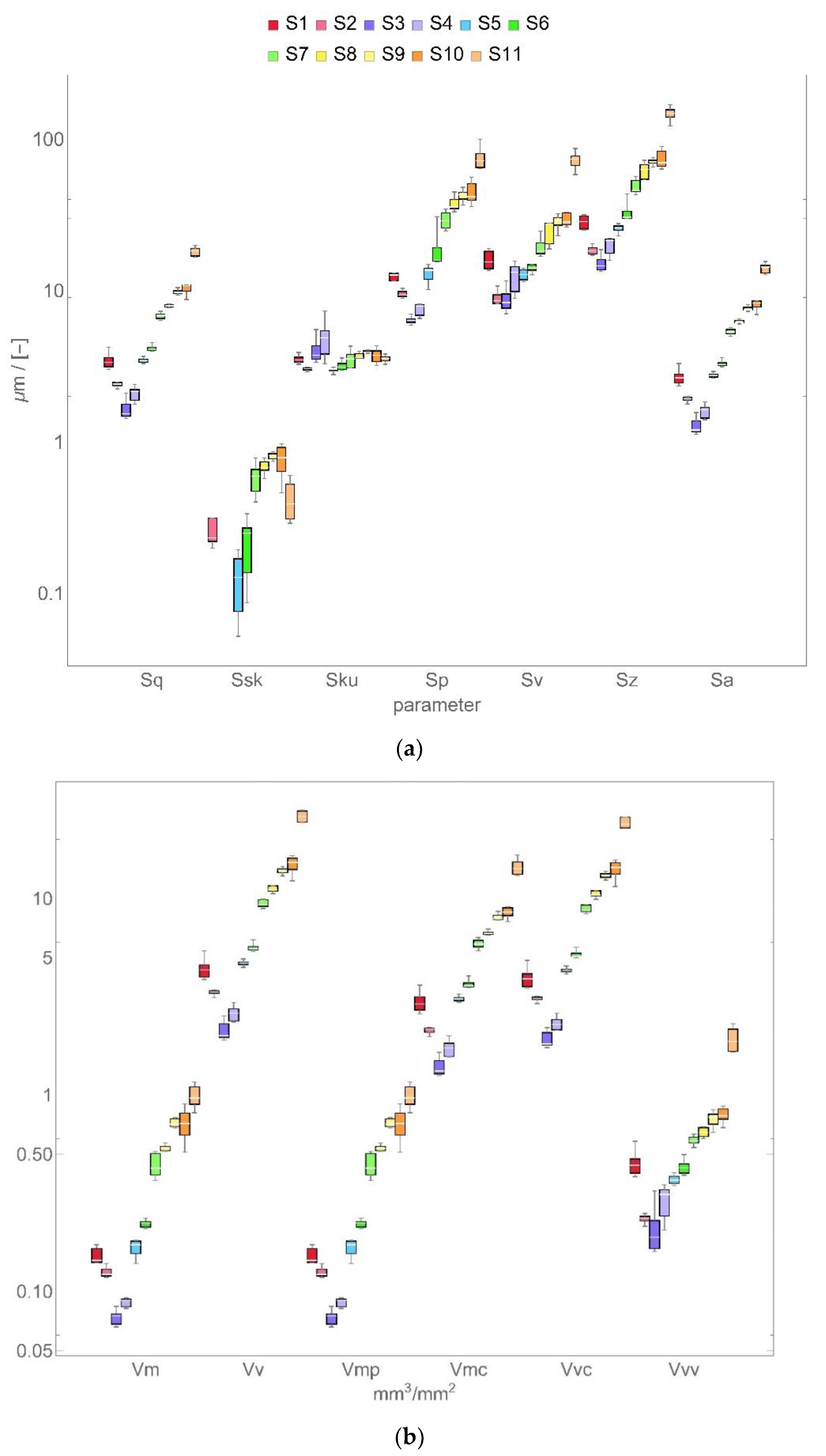
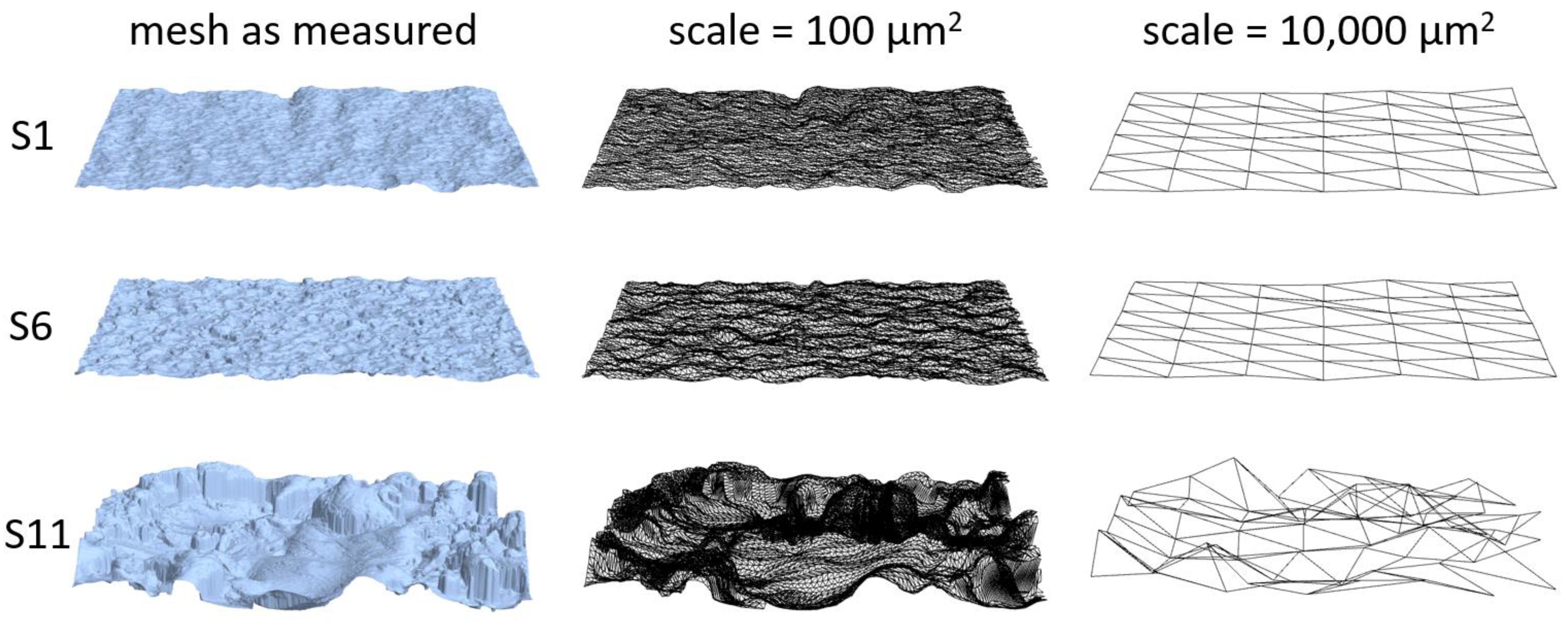

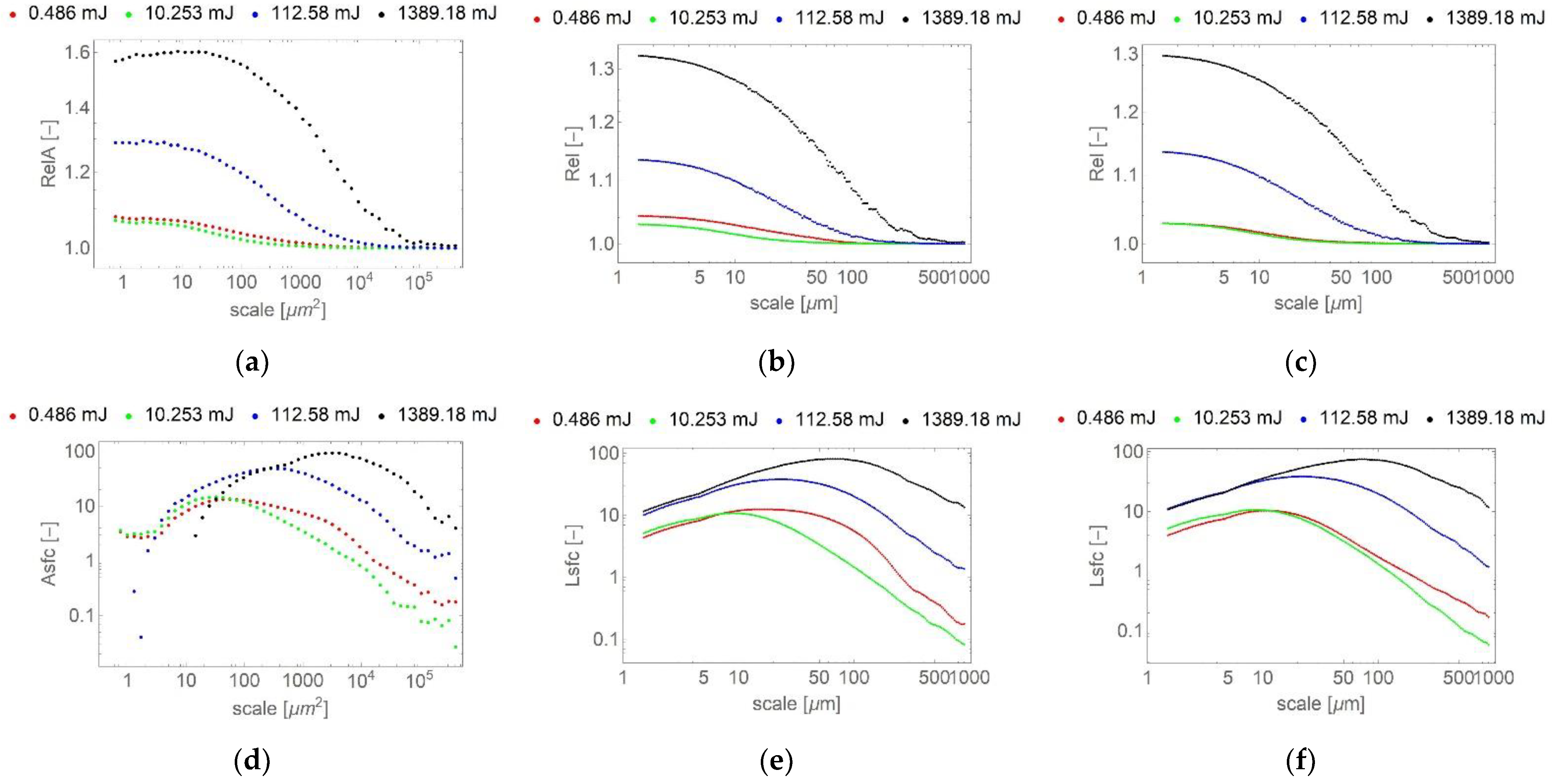
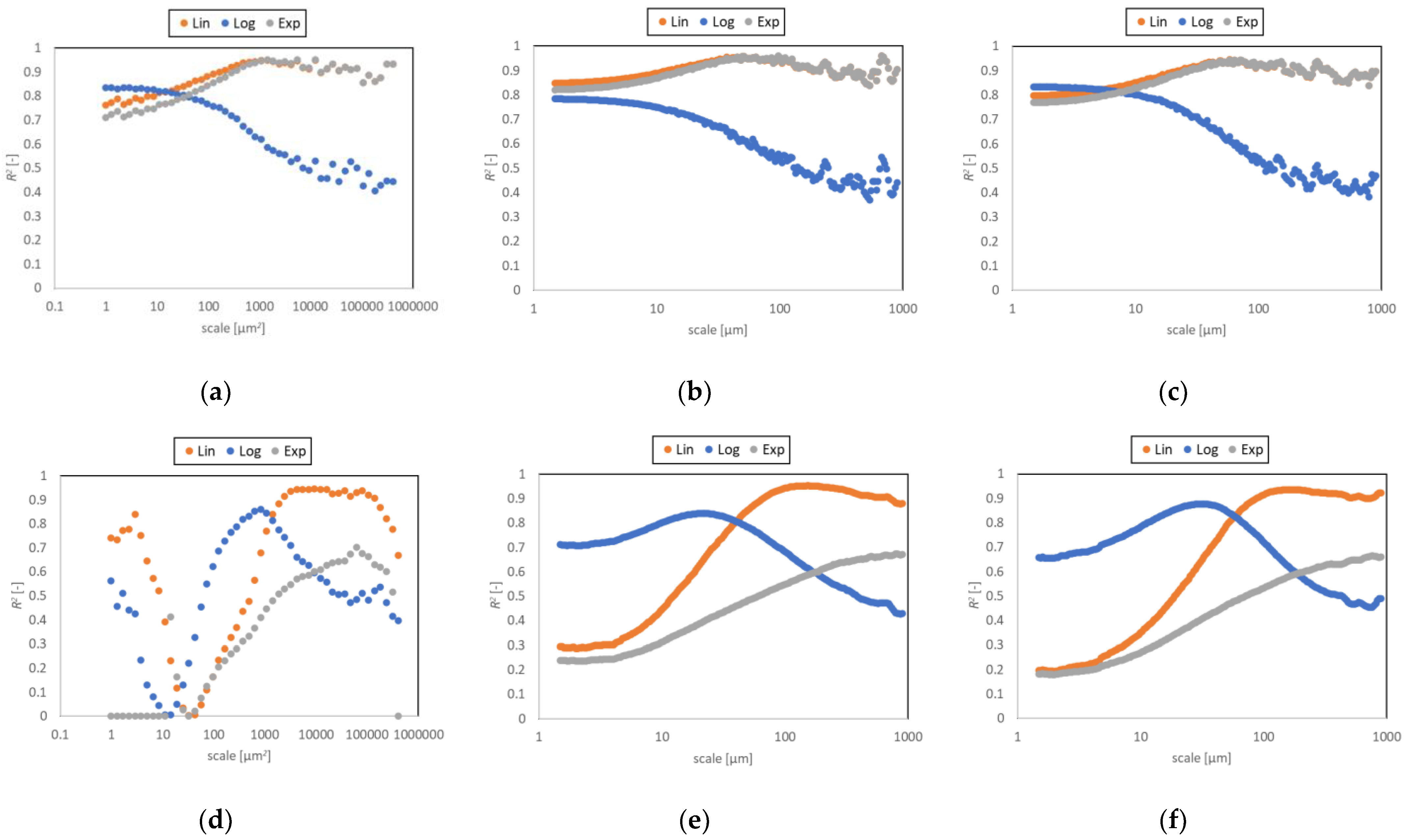
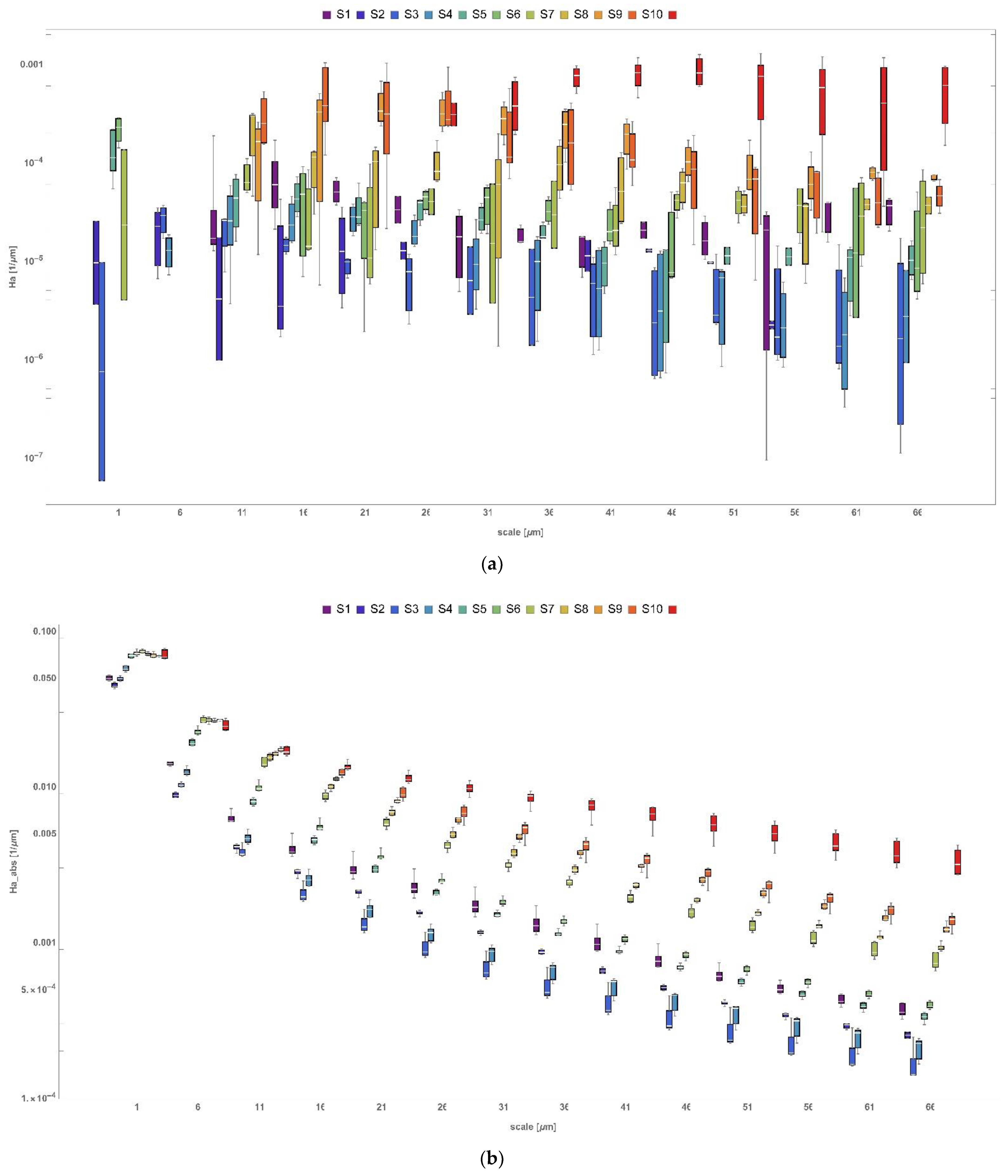
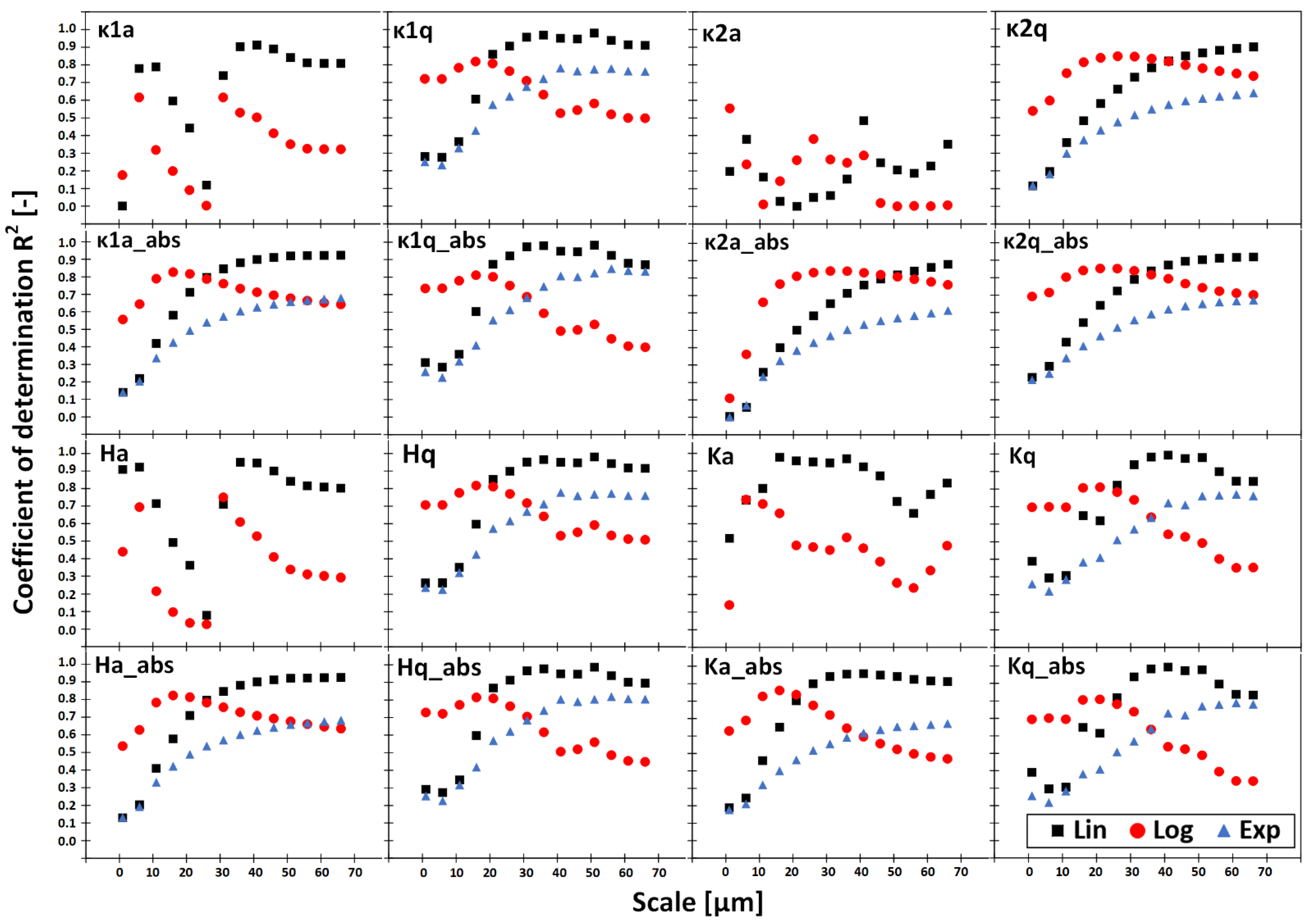
| Al | Si | Fe | Cu | Mn | Mg | Cr | Zn | Ti |
|---|---|---|---|---|---|---|---|---|
| rest | 0.3–0.6 | 0.1–0.3 | max. 0.1 | max. 0.1 | 0.35–0.6 | max. 0.05 | max. 0.15 | max. 0.1 |
| Surface | Voltage, V | Current, A | Single Pulse Time, µs | Break between Pulses, µs | Single Discharge Energy, mJ | Theoretical VDI Class | Theoretical Roughness Ra, µm |
|---|---|---|---|---|---|---|---|
| S1 | 150 | 1.2 | 2.7 | 15 | 0.486 | 15 | 0.56 |
| S2 | 160 | 1.8 | 8.7 | 15 | 2.506 | 18 | 0.8 |
| S3 | 180 | 2.4 | 11.5 | 15 | 4.968 | 21 | 1.12 |
| S4 | 180 | 3.2 | 17.8 | 18 | 10.253 | 24 | 1.6 |
| S5 | 180 | 4.4 | 20.5 | 27 | 16.236 | 27 | 2.24 |
| S6 | 100 | 6.2 | 23.7 | 37 | 14.694 | 30 | 3.15 |
| S7 | 100 | 10 | 31.6 | 49 | 31.600 | 33 | 4.5 |
| S8 | 100 | 13 | 86.6 | 49 | 112.580 | 36 | 6.3 |
| S9 | 100 | 21 | 133.4 | 49 | 280.140 | 39 | 9 |
| S10 | 100 | 29 | 237.1 | 49 | 687.590 | 42 | 12.5 |
| S11 | 100 | 39 | 356.2 | 49 | 1,389.180 | 45 | 18 |
| Parameter | Unit | Value |
|---|---|---|
| Magnification | – | 50× |
| Area size | μm | 900 × 900 |
| Estimated vertical resolution | μm | 0.022 |
| Estimated lateral resolution | μm | 1.500 |
| Lateral sampling intervals | μm | 0.176 |
| Standard | Parameter Group | Parameter Symbol |
|---|---|---|
| ISO 25178 | Height | Sq, Ssk, Sku, Sp, Sv, Sz, Sa |
| Functional | Smr, Smc, Sxp | |
| Spatial | Sal, Str, Std | |
| Hybrid | Sdq, Sdr | |
| Functional (Volume) | Vm, Vv, Vmp, Vmc, Vvc, Vvv | |
| Feature | Spd, Spc, S10z, S5p, S5v, Sda, Sha, Sdv, Shv | |
| EUR 15178N | Functional Indices | Sbi, Sci, Svi |
| - | Other | Smean, Sdar, Spar |
Publisher’s Note: MDPI stays neutral with regard to jurisdictional claims in published maps and institutional affiliations. |
© 2021 by the authors. Licensee MDPI, Basel, Switzerland. This article is an open access article distributed under the terms and conditions of the Creative Commons Attribution (CC BY) license (https://creativecommons.org/licenses/by/4.0/).
Share and Cite
Peta, K.; Mendak, M.; Bartkowiak, T. Discharge Energy as a Key Contributing Factor Determining Microgeometry of Aluminum Samples Created by Electrical Discharge Machining. Crystals 2021, 11, 1371. https://doi.org/10.3390/cryst11111371
Peta K, Mendak M, Bartkowiak T. Discharge Energy as a Key Contributing Factor Determining Microgeometry of Aluminum Samples Created by Electrical Discharge Machining. Crystals. 2021; 11(11):1371. https://doi.org/10.3390/cryst11111371
Chicago/Turabian StylePeta, Katarzyna, Michał Mendak, and Tomasz Bartkowiak. 2021. "Discharge Energy as a Key Contributing Factor Determining Microgeometry of Aluminum Samples Created by Electrical Discharge Machining" Crystals 11, no. 11: 1371. https://doi.org/10.3390/cryst11111371
APA StylePeta, K., Mendak, M., & Bartkowiak, T. (2021). Discharge Energy as a Key Contributing Factor Determining Microgeometry of Aluminum Samples Created by Electrical Discharge Machining. Crystals, 11(11), 1371. https://doi.org/10.3390/cryst11111371









